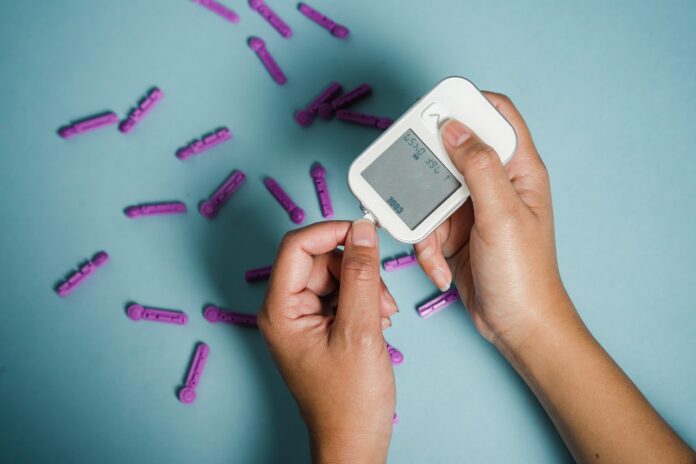Diabetic retinopathy is a complication that arises due to uncontrolled levels of blood glucose. This can lead to impaired vision or loss of vision in the eye. It is associated with damaged blood vessels in the retina, blurry vision, pain in the affected eye and discharge of fluid or blood from the affected eye. In its early stages, diabetic retinopathy is difficult to detect due to the absence of symptoms. Therefore it is advisable to go for a diabetes control programme and consult a physician if you are experiencing regular discomfort in your eye, which may be accompanied by blurriness or loss of vision.
Table of Contents
Symptoms of diabetic retinopathy
Diabetic retinopathy should not be taken lightly. It can lead to loss of vision and blindness. Several symptoms are indicative of diabetic retinopathy, the most common ones being blurriness that may or may not be accompanied by pain.
If someone around you suffering from diabetes is unable to view the television screen properly or is repeatedly complaining of the inability to read even while wearing glasses, you should encourage them to get checked.
Here are some symptoms that can help the diagnosis of this condition and prevent further deterioration of the eye.
- Blurred vision: The person experiences impaired vision. Their viewing abilities become hazy and unclear.
- Floaters or random spots: The blurriness is only in a patch of the eye that distracts the individual’s proper field of vision.
- Partial night blindness: Sometimes, the individual reports normal viewing in the daytime but their association with their surroundings drops drastically at night.
- Pain in the eye: Individuals feel pain in the affected eye. Exposure to longer than normal periods of reading or watching television can lead to discomfort. Patients also report pressure in the affected eye.
- Loss of vision: In advanced cases, there can be a sudden and complete vision loss in patients bordering on blindness.
- Eye discharge: Sometimes retinal fluid discharge takes place in cases of diabetic retinopathy. This may or may not be accompanied by blood, as a result of capillaries bursting open in the eye.
Treatment of diabetic retinopathy
Diabetic retinopathy treatment is typically divided into two parts. The first is preventive care, which helps put a check on the conditions that can lead to diabetic retinopathy. The second is active medical treatment, which may be invasive or non-invasive, depending on the severity of the condition. For effective preventive care, it is advisable to go for a diabetes control programme or a diabetes management plan.
Diabetes control programme
Prevention is always better than cure. More so, in diabetic retinopathy. You do not want to turn a blind eye because you didn’t attend to the symptoms in time. The first step to preventing any condition as a result of diabetes is to manage your sugar levels. If you do not attend to it in a timely manner, excess glucose in the bloodstream could start taking its toll on the vital organs of your body.
Consult a doctor and get enrolled in a diabetes control programme or get yourself a diabetes management plan to keep the sugar level in check. The doctor will come up with a combination of dietary plan, exercise, medication and regular checking of blood sugar levels.
Some precautions to bear besides regulating blood glucose, include keeping an eye on your blood pressure and cholesterol levels. Avoid smoking and drinking as much as possible. Alcohol contains high-calorie levels and sugar, both of which are disastrous for people with diabetes. An important part of treating diabetic retinopathy is its early detection. If your eye is discomforted, in pain or under pressure, consult your physician immediately. Always remember, a diabetes control programme is better than diabetic retinopathy treatment.
Medical treatment
When this condition surfaces without warning, you should seek urgent medical help. Doctors can help you take care of the condition and prevent your eye from going blind. Some procedures followed in diabetic retinopathy treatment are listed below.
- Laser surgery is used by doctors to seal off the ruptured blood vessels and shrink the ones that have grown abnormally and risk bursting in the future.
- Injectable drugs are used by doctors to decelerate the progression of the condition. This is done by injecting the medicines directly into the eye.
- Vitrectomy is the last resort for doctors in diabetic retinopathy treatment. The procedure refers to an invasive surgery where the affected eye is operated upon. Surgeons can successfully remove scar tissues and treat the affected blood vessels.
Is reversal of diabetic retinopathy possible?
This brings us to the question: can a diabetes control programme reverse diabetic retinopathy? The short answer is: no. Diabetic retinopathy can affect people with Type-1 and Type-2 diabetes. It makes no distinction in how you acquired diabetes. Prevention can help in keeping your eyes safe and healthy. It also allows for timely detection of the condition giving you a better shot at treatment and care. Diabetic retinopathy treatment will help keep the condition in check and prevent it from worsening.





